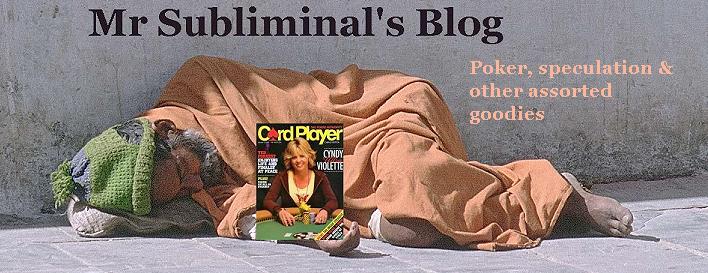Finally, some sorely lacking poker content. Shelly recently posted an interesting hand she played at the Trump, Atlantic City :
What would you do?
I'm going to leave out most of the information regarding reads I had on my opponents. If you care to respond, please explain what you'd do and why. I'll update with my reads and what really happened.
You're at Trump in the 2/5 $200 max NL game. You've got about 4x the max buy-in in front of you (800). A tilting short-stacked player limps ahead of you (his stack: <75). You raise 5x the big blind to 25 (standard raise for this table is 20). You have KK. Action folds to the big blind, who pushes all in. He has you covered (ie. he's got more than 800 in chips in front of him). Tilting short-stack calls all-in.
What do you do? Call or fold?
I left the following comments to the above post :
For me, this is a clear fold. There is no need in putting the BB on a range of hands nor for any EV calculations. With only $25 invested in the pot, great confidence in my post-flop playing ability, and all the time in the world, I don't feel the need to risk my entire stack (four buy-ins) no matter what he's holding. And while I said before there's no need for any hand reading here, for the BB to risk $800 pre-flop there is a good chance that he has AA. But even if he has 93o, good luck to him. To be honest with you, I wouldn't even be interested in knowing what he had. This ain't no tournament. I'm folding. Next hand.
Of course if I only had $200 (one buy-in) in front of me, I would insta-call.
Absent any other concrete information, this is an automatic fold for me. The last person I want to tangle with is the other large stack, unless of course I'm certain that I have a substantial advantage. So yes, I'd call in a heartbeat if I had AA. And if he showed 66, I'd call with 77. But here, I muck the kings, face down and very quickly.
Shelly has since posted a follow-up in which she outlines the reasoning behind her play and I urge you to spend the time to read it as I will not repeat it here.
Great post and thanks for sharing, Shelly. I've already outlined my opinion in the comments section (above) and even though I disagree with her, I believe there is no right or wrong decision here, just a matter of preference. This becomes even more apparent after we are informed of Big-stack's previous predilection for the all-in move.
Without trying to proselytize, allow me to provide some further food for thought vis-a-vis probabilities and stack sizes. The odds Shelly states of having a KK vs. AA matchup do not take into account conditional probability. Given the size of his bet, his penchant for all-ins notwithstanding, the probability of his holding AA could lie in a subjective range anywhere from 20% to 80%. She has given us his holdings (AK twice, AQ, JJ, and TT) for his previous all-in moves. But what did he have on the previous Degree All-In Moments when Shelly had raised 5 BB? Is there even a data set? So her perceived edge may not have been as high as she initially thought, perhaps 60% favorite or even less.
Let's assume she was 60% favorite. Poker is all about applying small edges repeatedly. I can apply small edges repeatedly when my stack size is similar to most other players'. Forgetting the smaller pots for the moment, each all-in with me as 60% favorite will, in the long run, yield me $x. No problem, bring 'em on. When I have my little edge, there will be no shortage of opportunities to make $x. And the law of averages will take care of me. But what happens when I'm the large stack and there's only one other at the table? Sure, my expected gain per showdown is $y, where y>>x, but I'd like to be able to apply this edge repeatedly, not just once every 20 sessions, or how often it is that I and at least one other soul are fortunate enough to quadruple up. Naturally there is a point at which I'm willing to turn a blind eye to this social inequity, but I'd have to be 80% favorite or better. I'm assuming that I'm playing at the highest level my bankroll permits and that the maximum buy-in is capped.
Shelly's point of view is legitimate in that poker is one long session. She's young and has more time than I do.




3 comments:
Thanks for your feedback! The funny thing about the Trump game (Indiana, not AC - I wish I was in AC!) is that quadrupling your buy-in is right about when poker starts getting played. It's a daily occurrence to see people walk off of those tables with $2k or more, easily. It's dubbed the "ATM game," as so many people wear a path in the carpet from the table to the cash machine. So - my 800 bucks really was nothing special. It's a good chunk of change to me (since that game is as high as my bankroll will allow), but there are a lot of casual players donating money there.
I'd love to soon be telling the story of walking off the tables there with a couple grand :)
Also - I somehow missed you on my blogroll! Adding you now :)
Sounds like a great game!
Nice writeup.. I thought the same, calling or folding is a style issue, but in a cash game there is always another hand and if you like your post flop game why not wait for a chance to outplay someone.
Post a Comment